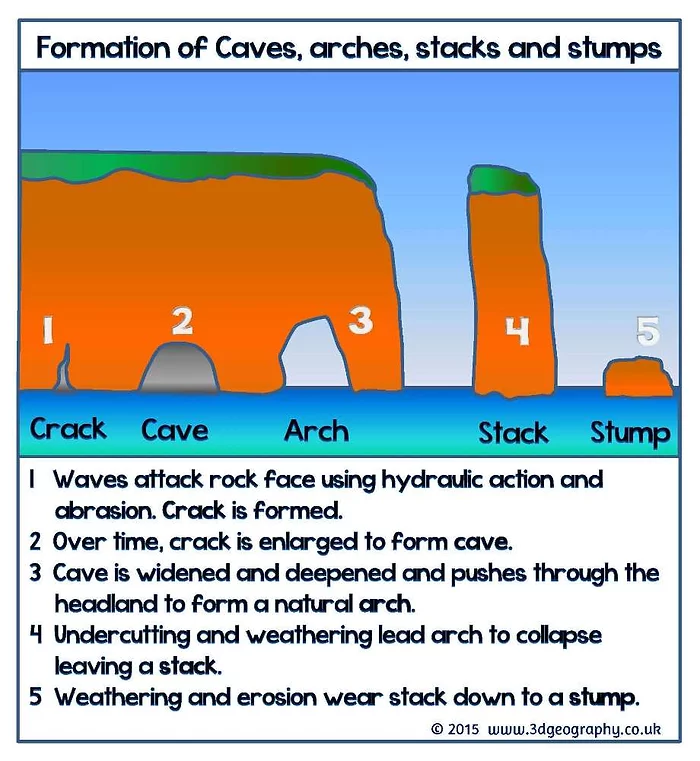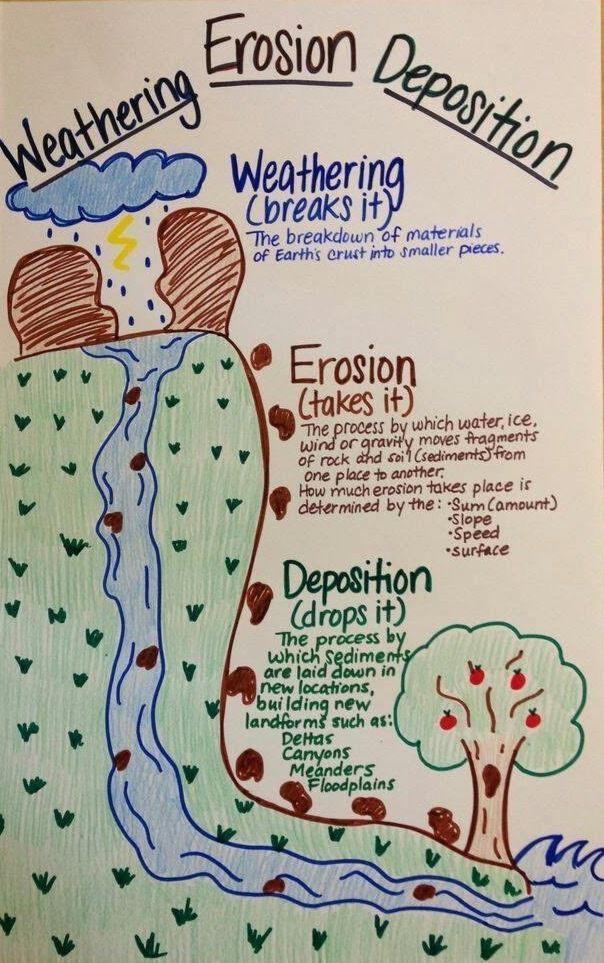Home > Sections > Earth > Weathering & Erosion
Last Updated: 14th June 2023
ARCHIVED ITEM: this page is no longer updated.
Weathering & Erosion
Keywords
Weathering, erosion, physical weathering, biological weathering, chemical weathering, hydraulic action, abrasion, attrition, solution, mechanical weathering, deposition.
Introduction
We all know that the Earth has properties such as sand, stones and rocks available. But why are they the shape they are, and why do they get smaller from being so large?
Let's find out.
But First, a Video...
Here's a YouTube video from Moo Moo Maths & Science to explain how erosion & weathering work:
Erosion
Erosion is the process of wearing down river beds and banks, or the sides of the river. This is done through the water in the river moving through it, breaking pieces of it apart as it goes along. But, there are four main parts to erosion:
Hydraulic action: just the sheer pressure of the water running down the river breaks up the bank or riverbed. Take a garden border for example. It's dry and in the summer, and you water the plants in said border. What happens to the water first off? It hits the groud, and then once it's hit the ground by your plant, about 30% of that water goes into the ground where it lands. The rest? That runs off along the top of the border ground and finds a nook or small space to seep into.
Abrasion: we think of abrasion when we think of a piece of sandpaper on a piece of wood. When you rub the sandpaper, it takes a layer of the wood off, using the friction created from the sandpaper itself. This happens in the river; when stones move along the river bed, they hit other stones along the way, causing this sandpaper effect.
Attrition: Stones that are moved from one place to another along the river knock into each other and break apart. It's like when you drop a rock or stone from a height, it will break apart, probably into several pieces. In the river, this happens and they either erode slightly, or break up into smaller stones.
Solution: when you take the first three explanations into consideration, this last one is the easiest to explain. If you put sugar into water, it dissolves, and depending on how much sugar you put into the water, it eventually sediments at the bottom of whatever you have it in. This is the same as solution in a river. Quite often named silt, the materials are moved along the riverbed and eventually dissolve into the water. This is then the solution.
Another term used for the movement of rocks, stones and silt from one place to another is called deposition. This a fancy term, but you may find it useful to use, or explained here. This can be done either by the river moving it from one space to another, or from rain (in form of sand - every year sand is picked up from the Sahara Desert, and dropped in the UK).
Interesting fact: Erosion can have damaging effects on aquatic life and can also cause sedimentation. This can make it difficultfor aquatic life to breathe and survive.
Weathering
Weathering is slightly different to erosion. Well, weathering can cause erosion to happen, but it is the precursor it. Weathering includes the types of weather that happen throughout the year to make something break apart.
Let's say you have a mound of mud. It contains small stones, but this is essentially just a mound of mud. Now, add in the fact that that mud is layers upon layers thick (say, inside a raised bed). But this mud has the ability to expand and contract, much like a wooden door does in a door frame.
So, during the day, it rains, and this mud become wet. The majority of the water goes through the mud and seeps away to some other place (maybe to the level of the water table). What happens to the rest that stays with the mud? Well, at night time, it becomes cold. And this particular night, it becomes so cold that it freezes over. So, now your raised bed has stone cold watery mud in it, and the water turns to ice.
Expansion occurs. The mud expands because of the water. When morning approaches and the sun comes out and defrosts it, it makes the mud smaller and contract. When this occurs, it could [potentially] break the bed the mud is sitting in. Potentially. Depends on how well your raised bed is made.
Another example of this is with a patio. A patio has cracks between each slab to allow for breathing. That's right, breathing space. You normally place sand or cement in between these cracks, to keep them in place and to stop them moving, etc. This is fine, but over time, they will expand and contract, and then they eventually make a slab or two crack. This is all down to weathering.
Types of Weathering
There are three main types of weathering, including:
Mechanical: the examples above are types of mechanical weathering, allowing for expansion or contraction.
Chemical: rainwater can be slightly acidic, and can wear down rock over time.
Biological: plants and animals can wear away rocks too - roots can break away rocks, or small animals like rabbits when they burrow into the ground.
Eventual wear and tear of the earth in such ways can result in mass movements. These are commonly known as landslides or soil creep (which is slower). They occur when there are changes in the local ecosystem due to weathering.
Footnotes
How coastal erosion occurs through force of the sea, courtesy  3D Geography.
3D Geography.




 Ecosystem
Ecosystem

